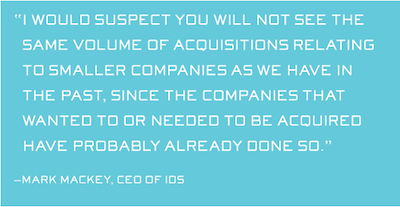Names like Great Western Financial, Bank One and Wachovia have slowly started to fade out of circulation, leaving four megabanks to conduct most of America's banking business.
From 1990 to 2015, JPMorgan Chase, Citigroup, Bank of America and Wells Fargo devoured more than 30 different banks and transformed themselves into the giants they are now.
While this eat-or-be-eaten way of conducting business is familiar enough to the banking industry, it could be starting to catch fire in a new area — the mortgage documentation space.
Every day, a new crop of technology companies works to develop solutions to solve something inefficient in the housing industry. And every day, they have to look over their shoulders.
Back in 2012, Facebook shocked the nation when it decided to buy Instagram for $1 billion, a steep price tag for a company that generated no profit.
An article about the acquisition published inThe New York Times titled, “Facebook plays offense and defense in a single deal,” explored the strategy behind the move:
Reid Hoffman, a co-founder of PayPal who went on to found LinkedIn, the social networking site, said in an interview on Tuesday that acquisitions were made partly to gain something valuable, but also to stave off the competition. “History shows they fail most of the time, but when they win it’s very valuable,” he said. “There’s always the blended question of opportunity and threat.”
Young hot technology companies are nothing if not aware of their mortality. Because so many started out by wounding an older tech giant, they know they can be killed, or at least severely injured, by that which lurks in the rented office space of Silicon Valley — an even hotter, younger technology company.
Echoes of this can already be seen in the housing industry.
For example, at Goldman Sachs’ annual housing finance conference in New York this year, one panel session specifically covered mortgage innovation and where the industry needs to be headed.
During the session, one of the panelists said, “If we don’t begin to innovate in mortgage, someone in a hoodie in San Francisco will do it.”
That remark got a joking response from another panelist who said, “I don’t wear a hoodie but I live and work in San Francisco and SoFi already did.”
That panelist, Mike Cagney, is the CEO of Social Finance, better known as SoFi, which is a San Francisco-based company that was founded on standard student loan refinancings. Lately, however, the company has been moving into the next important stage for borrowers — purchasing a home.
SoFi is not simply trying to break into mortgages, it is trying to transform the world of mortgage and bring the entire process online.
Over the last couple of years, as the mortgage industry has worked hard to put the entire mortgage process online, it has created a lot of opportunity for housing technology companies to step in and make new a solution or application.
But how much of a lifespan do these small companies have, or will they have to resort to being acquired in order to survive in the vast ocean of tech start-ups?
The ComplianceEase example
Burlingame, California-based ComplianceEase, a provider of automated compliance solutions, announced in March that it acquired the assets of Mortgage Banking Systems, a provider of mortgage document preparation and closing software solutions.
Mortgage Banking Systems’ main product is ProClose Platinum, which is a software-as-a-service document preparation and management solution for mortgage lenders, incorporating the most up-to-date MISMO mapping standards.
The company is headquartered in McLean, Virginia, and has specialized in cloud-based closing document software for mortgage companies for more than 20 years, providing services for financial institutions, service providers, law firms and GSEs.
So what’s ComplianceEase’s motivation for acquiring a document company? Regulatory changes.
John Vong, president and co-founder of ComplianceEase, explained that the acquisition will help the company be able to respond to all of the regulatory changes on the horizon, including the TILA-RESPA Integrated Disclosure rule, enabling lenders to focus on their core business.
“Adding SmartCloser to our suite of solutions will allow our users to receive updates regarding any last minute changes that occur in the loan closing process, before these changes trigger re-disclosure requirements,” Vong said.
ComplianceEase and ProClose have partnered for the past 10 years to deliver the integrated closing solution ProClose Platinum, which has now rebranded as SmartCloser. As a result of the acquisition, ComplianceEase can create a comprehensive solution that will help residential mortgage lenders comply with the TILA-RESPA Integrated Disclosure rule that takes effect Aug. 1, 2015.
Under the agreement, the entire ProClose team is joining ComplianceEase, and Christine Kirby, CEO and president of ProClose, will become vice president of ComplianceEase.
The small company advantage
ComplianceEase’s acquisition of Mortgage Banking Systems is an example of the types of mergers that have been typical within the industry. But how many more of these companies are there?
 Mark Mackey, CEO of IDS, said he thinks most of the smaller companies that could not keep up with the rapid acceleration of compliance changes over the last few years have either gone out of business or have already been acquired.
Mark Mackey, CEO of IDS, said he thinks most of the smaller companies that could not keep up with the rapid acceleration of compliance changes over the last few years have either gone out of business or have already been acquired.
“I would suspect you will not see the same volume of acquisitions relating to smaller companies as we have in the past, since the companies that wanted to or needed to be acquired have probably already done so,” he continued.
Scott Stucky, chief strategy officer for DocuTech, thinks that smaller companies could have some advantages in this environment. They can often be more nimble and innovative than larger companies.
“Smaller companies can thrive on their own without needing an acquisition to survive,” he said.
“While there are a number of overhead burdens to serving this industry — data security, information privacy, financial audits, etc. — small companies have and will continue to thrive if they use their competitive advantages.”
DocuSign presents still another route to success. Rather than operating by itself or being acquired, DocuSign chose a simpler solution: forming an alliance.
DocuSign has several strategic partnerships that secure the company’s position in the market, including one with the National Association of Realtors.
The two companies announced in April they had extended their strategic partnership, making DocuSign Professional Edition available to international Realtor members at a discounted rate.
“As the National Association of Realtors’ official and exclusive provider of electronic signature services under the Realtor Benefits Program, DocuSign’s platform has been helping NAR members in the United States accelerate business and delight clients for years,” said Jeff Hornberger, director of global alliances at NAR.
Lexmark International steps into housing
A recent move by Lexmark International demonstrates another tried and true strategy: a large firm, with little housing experience, gets into a highly regulated market by acquiring an industry veteran.
In March, Lexmark International purchased document-capture software provider Kofax for approximately $1 billion, in a move that instantly gave Lexmark a significant digital role in housing.
Lexmark, which is based in Lexington, Kentucky, focuses on connecting unstructured printed and digital information across enterprises with the processes, applications and people that need it most. Meanwhile, Kofax is based in Irvine, California, and is a provider of smart applications to simplify and transform customer engagement.
“Kofax accelerates Lexmark’s development of industry-specific solutions while also immediately expanding our reach into the midmarket, where there is increasing demand for technology to better manage the growing amount of unstructured information and improve customer engagement,” said Paul Rooke, Lexmark chairman and CEO.
The acquisition is a win-win for Lexmark. It’s able to enter the lucrative world of housing with the history and legacy experience necessary to operate in the complex market.
Under the agreement, printer behemoth Lexmark will nearly double the size of its enterprise software business to an approximately $700 million stake, competing in the expanding $10 billion content and process management software market.
Lexmark will acquire all of the outstanding shares of Kofax for $11 per share in cash, for a total enterprise value of approximately
$1 billion.
“Our market-leading ability to simplify and transform the First Mile of customer engagement is a strong complement to Perceptive Software’s strength in managing information across silos.
“As a result, we’re excited about the future and working together to realize the full potential of this opportunity to the benefit of all stakeholders,” said Reynolds Bish, CEO of Kofax.
Shortly after announcing it acquired Kofax, Lexmark announced the company’s new corporate brand and logo, reflecting both the evolution of the company as well as its vision for the future. Lexmark has acquired and integrated several other software companies since 2010, further expanding the company’s range of offerings to include innovative software solutions.
Go big or go home?
Lexmark is not alone in its desire for part of the housing pie. As mortgage lenders claw their way back from the crisis, big players across the spectrum see more opportunity.
For example, at the beginning of 2015 Google announced two significant moves that might pave its way into mortgage lending. First, Google released a mortgage payment calculator, which appears when a user searches for terms like, “mortgage calculator,” “loan interest calculator,” and “interest calculator.”
Secondly, at the time of publication, Google is said to be preparing to launch a mortgage comparison tool via its Compare service. Currently, the U.S version of Google’s Compare service only allows users to compare different credit cards.
But in the United Kingdom, Google Compare features car insurance, travel insurance, credit cards and mortgages.
Yahoo was quick to follow suit, and in March, it began offering a built-in mortgage calculator, available both within searches and as a standalone page. Yahoo users can now see a native mortgage calculator when conducting searches for “mortgage calculator,” “loan interest calculator,” and “interest calculator.”
As the tech giants look to get into the mortgage finance space, companies who offer third-party solutions seem like low-hanging fruit.
“Doc management is an attractive market position for a number of firms not already in the space,” Stucky said. “There have been some large firms not necessarily associated with the mortgage industry that have acquired technology firms in the past few years and some venture capital firms that have done the same.”
And with the industry stabilizing, that trend is likely to continue, he said.
“Any change in the industry creates potentially positive and negative possibilities. A large number of acquisitions could reduce the number of providers, possibly stifling innovation, while on the other hand, it may drive down cost and increase efficiency.”




